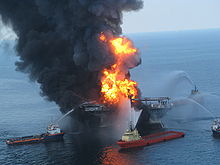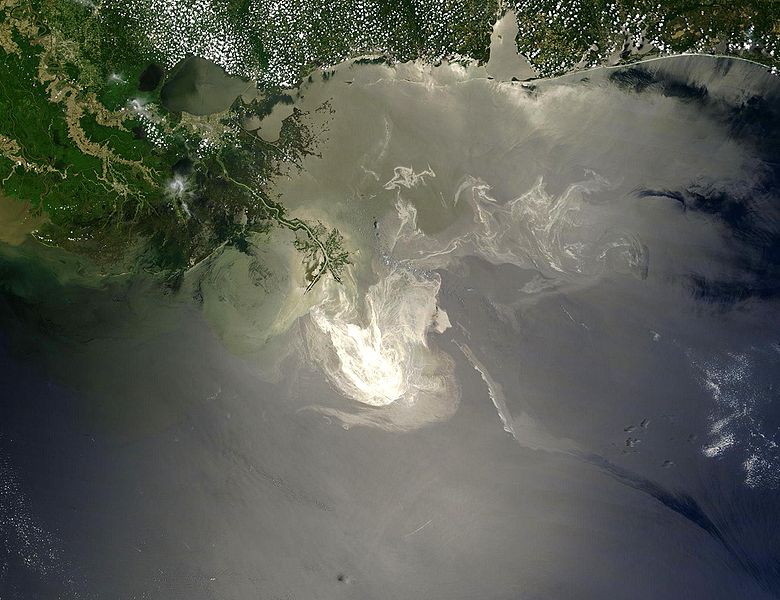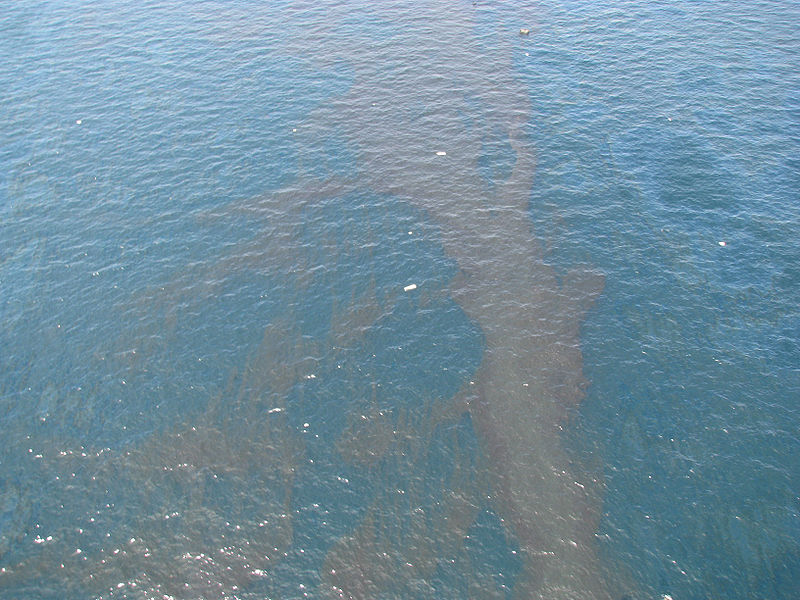The Deepwater Horizon Oil Spill and Research Response
January 12, 2022
Excerpt from From Air to Land to Sea: 50 Years of Educating Coastal Leaders (publication forthcoming)
By Nancy Rabalais

Deepwater Horizon on fire
The sequence of events for the Deepwater Horizon (DWH) oil spill began April 20–22, 2010, when the drilling rig caught on fire, exploded, and collapsed to the seafloor 1,500 m (4,900 ft) below, taking with it the lives of 11 platform workers. Oil from the ruptured Macondo wellhead spewed a collective five million barrels (210 million gallons) over 87 days before the wellhead was capped. The oil spill produced a surface area of at least 149,000 km² (57,500 mi²) that was carried at least 450 km (or nearly 300 mi) from the source. Concerns about the oil reaching valuable and vulnerable shorelines in the northern Gulf of Mexico prompted the federal Unified Command to approve the use of dispersants, both on the water surface and at the wellhead, in order to limit the amount of oil reaching the shore. The DWH oil spill off the coast of Louisiana was the largest marine oil spill on record and resulted in more shoreline oiling than any previous spill.
The immensity of the spill, use of dispersants at the wellhead, discovery of a subsurface oil plume, and the overlap with unique communities (deepwater corals) and many highly migratory and long-lived animals (e.g., threatened and endangered sea birds, sea turtles, whales, porpoises, and tuna) challenged researchers who followed the fate and effects of the oil in offshore environments.
Brownish oil/dispersant emulsions (‘mousse’), oil droplets, tar balls, and surface sheens began reaching shorelines in May 2010. The oiling of beaches, salt marshes, mangrove stands, seagrass meadows, and estuarine waters continued well after July 15, the day of capping of the Macondo well. The majority of all oiled shorelines (2,113 km, 1,313 mi) and most marsh oiling were in Louisiana (>60% and 95%, respectively).
It was not surprising that the LSU Department of Oceanography & Coastal Sciences’ (DOCS) faculty and their colleagues focused on nearshore waters, estuaries, and marsh habitats. After all, the DWH oil spill occurred in the backyard of LSU (65 mi southeast of the Mississippi River Delta) where past studies of oil and gas development, oil spills, and marsh ecosystems were within the expertise of many LSU researchers. This summary will focus on those ecosystems. Teams of LSU DOCS faculty and researchers, many from other LSU departments, and national and international oil spill experts, came together immediately and studied the spill and its effects for 11 years, and continue now. Many publications were and continue to be added to the DWH scientific legacy—ranging from its chemistry and toxicity to transport in ocean and estuary currents, from the microbes and microbial processes to plant and animal communities in multiple habitats, and from lethal to sublethal to undocumented effects on living organisms.
Continental Shelf

Spilled oil spreading from Deepwater Horizon across the Gulf of Mexico
The oil/water/dispersant mixture from the 2010 DWH spill was juxtaposed on the Louisiana continental shelf with the annual development of oxygen-depleted bottom waters. The media projected a dire effect of DWH hydrocarbons on the ‘dead zone’ in the summer of the oil spill. However, there was no evidence that DWH oil residues affected the typical seasonal development of bottom-water hypoxia in 2010. The analysis indicated that, in the 24 years compared, the hypoxic area increased with higher river discharge, higher nitrate-N load, and an easterly (westward) wind and reduced wind speed, and these relationships were not different in the summer of 2010. The 2010 shelf phytoplankton community composition exposed to the DWH oil spill differed from the longer-term data, but the comparisons were not consistent. Some shifts in phytoplankton communities were lower abundance for some phytoplankton groups and higher abundance for others. Cultured phytoplankton exposed to a Macondo surrogate oil exhibited a range of responses that were evident—no response, reduced growth rates with longer lag time to exposure, some or no inhibition of photosynthetic efficiency; all responses were species dependent.
The concentrations of alkanes and aromatic hydrocarbons in Macondo oil measured in nearshore waters were transferred to estuarine waters and marshes in comparable concentrations. The initial high concentrations within the estuary and in marshes were 800 times higher than pre-spill values for alkanes and 60 times higher for aromatic hydrocarbons. The concentrations of each category began a gradual decline through about 2013, but by the end of 2018 had not approached pre-spill concentrations but were 10 times higher for alkanes and 100 times higher for aromatics than pre-spill.
Coastal Marshes

An oil sheen from Deepwater Horizon
When Macondo oil reached salt marshes, it came in unevenly with marsh shorelines categorized as heavily, moderately, or lightly oiled or not oiled. Re-suspension and re-distribution of oiled sediments, especially during Hurricane Isaac, pushed oil farther into the marsh, where it was as high a concentration at the shoreline as it was 100 m into the marsh. There was a dieback of all marsh vegetation in ‘heavily’ oiled areas. The typical scene was the absence of living vegetation and the presence of dead stems layering the exposed, oiled sediments. When erosion did not occur, then vegetative cover began to recover after a year but was much lower than in reference sites. Recovery in live aboveground biomass and stem density of the dominant marsh plant (Spartina alterniflora) was about 10 times greater than that in Juncus roemerianus, another common marsh plant, in ‘moderately’ oiled marsh.
Salt marsh macrofauna, the periwinkle snail, mussels and fiddler crabs, were negatively impacted. The density of crab burrows was almost 40 percent less in oiled sediments than unoiled, and density and crab size were not recovered until at least four years after the spill. The older (larger) mussels were largely absent. The abundance of periwinkles, which feed on sediment surface microalgae and algae on the stems of Spartina, was severely reduced in oiled habitats, and recovery was slow, at least nine years post spill. Some estimates of recovery suggest that the populations will be reduced for as long as two decades. Recovery of organisms followed a progression of repopulation of benthic microalgae, small sediment organisms, and plants and their structure. There was disruption in the marsh killifish genome, physiology, and reproduction for populations in freshly and ‘heavily’ oiled marshes within two to four months after peak oiling. Subsequent field collections of marsh nekton, however, did not reveal any effects of oil exposure on population dynamics between oiled and unoiled sites. Possible explanations include behavioral avoidance and the open nature of the habitat.
A significant loss of marsh habitat occurred due to erosion of oiled shorelines and was additive to the negative effects of other human and natural processes contributing to coastal erosion in Louisiana. Marsh erosion measurements began at 30 sites within two months of peak oiling; measurements were hydrocarbon concentrations, vegetation cover, soil strength, and marsh overhang (the distance from the marsh edge to the back of the below surface undercut area). The marsh overhang for the high oil sites was significantly greater than for the low oil sites, with the exception of one sample. While there were no significant differences in the percent of Spartina vegetation cover for four of five sampling periods, the strength of the soil below 60 cm was much lower in high- and low-oil sites, pointing to the critical structural weakness leading to marsh breakup. After then, the erosion increased at intact marshes between the eroded areas as the promontories created by erosion of adjacent oiled sites left them exposed to wave action.
Human Impacts
In addition to the workers’ deaths and injuries related to the explosion of the DWH oil drilling platform, thousands more people were exposed to toxic oil fractions in cleanup operations around the spill both offshore and onshore, on beaches, and within marshes. Health effects on cleanup workers included an increased prevalence of illness symptoms such as shortness of breath, headaches, skin rash, chronic cough, weakness, dizzy spells, painful joints, chest pain, and mental health trauma for extended periods post spill. Many coastal community people lost livelihoods, either temporarily or permanently, when fisheries were closed. Small businesses related to fishing tourism closed and have not reopened. Many of the communities in the coastal areas of the northern Gulf of Mexico experienced health care disparities with poorer health amenities for under-represented populations.
The present reliance on petroleum energy sources has been accompanied by multiple unhealthful conditions for humans after an oil spill. Several components of coastal ecosystems have yet to recover nine years following the DWH spill. The knowledge base of the consequences of oil spills, although not complete with continuing documentation of DWH effects, is broad and deep. That knowledge base indicates that attention should be directed towards safe energy alternatives and prevention of oil spills for the health of natural ecosystems, including their human inhabitants.